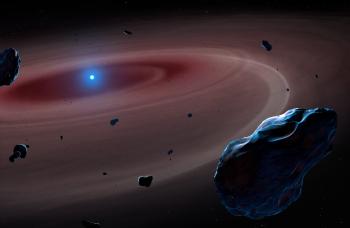The University of Warwick is Europe’s most successful user of Hubble Space Telescope
- University of Warwick is Europe’s leading user of the Hubble Space Telescope
- Students and academics have regularly used Hubble over the past decade, and their discoveries include the first water-rich asteroids outside our solar system, stars ‘consuming’ planets and objects brighter than 10m galaxies
- Warwick PhD students currently using Hubble to uncover the mysteries of stars that died before the Sun was born and how white dwarfs are ripping apart asteroids
- 2015 marks 25th anniversary of Hubble’s launch
Mysteries ranging from dying planetary systems to gigantic cosmic explosions are being unravelled by Europe’s leading users of the Hubble Space Telescope (HST). The competition to use this iconic space-borne telescope is extremely fierce, and in 2015 the University of Warwick’s Astrophysics Group was Europe’s most successful applicant to use the HST.
Launched in 1990 the HST is operated by NASA, the European Space Agency and the Space Telescope Science Institute. In orbit outside of the Earth’s atmosphere that is distorting the view of the Universe, and blocking parts of the light from reaching telescopes on the ground, the HST provides the detailed data necessary to conduct research into the evolution of stars, planets, and the Universe.
A new generation of astrophysicists are currently using HST at Warwick to research stars that died before the Sun was born and how white dwarfs are ripping apart asteroids as part of their PhD studies.
Commenting on the University of Warwick Astrophysics Groups’ use of HST Professor Boris Gänsicke, who is a veteran user of HST:
“Hubble is much more than a telescope, or a satellite: it is an outstanding masterpiece of human achievement. Not only do its spectacular pictures shape the way we think about the Universe, but at the same time the enormous efforts of the engineers and astronauts which keep it in orbit, and make it ever more powerful, are an unrivalled source of inspiration. I have had the extraordinary privilege to use this iconic telescope for nearly two decades to study the fascinating stories that stars and planets can tell us. It is a great pleasure to see the next generation of young astronomers having the same opportunities, pointing Hubble towards the sky to push further into the unknown.”
A few highlights of the Hubble observations that the Warwick researchers have carried out to:
- Discover of four white dwarf stars caught in the act of consuming earth-like exoplanets, as part of HST research to conduct biggest survey to date of the chemical composition of the atmospheres of dying stars:
- Find solar objects that are 7.5 billion light-years away and were once brighter than 10 million galaxies: http://bit.ly/1P8WYT9
- Uncover the first evidence of a water-rich rocky planetary body outside our solar system in its shattered remains orbiting a white dwarf: http://bit.ly/1UEbTqq
Discussing his research into stars and planetary systems that died before the Sun was born University of Warwick PhD student Mark Hollands said:
 “Astronomers are now finding that the remains of planetary systems around dead stars, known as white dwarfs, are in fact quite common. When these burnt-out cores of former stars gobble up shredded rocky debris from planetesimals or asteroids (the building blocks of planets like the Earth), that material changes the light of the star that we observe in such a way that we can work backwards, and uncover the actual chemical composition of the in-falling rocks. We can use this to answer important questions like "Are planets around other stars built from the same stuff as the planets in our Solar system?".
“Astronomers are now finding that the remains of planetary systems around dead stars, known as white dwarfs, are in fact quite common. When these burnt-out cores of former stars gobble up shredded rocky debris from planetesimals or asteroids (the building blocks of planets like the Earth), that material changes the light of the star that we observe in such a way that we can work backwards, and uncover the actual chemical composition of the in-falling rocks. We can use this to answer important questions like "Are planets around other stars built from the same stuff as the planets in our Solar system?".
“Pinning down in detail the chemistry of the material of these exo-planetesimals, as well as the age of the white dwarf requires detailed modelling of the starlight, from the infra-red, all the way into the ultra-violet. It is the ultra-violet that remains the greatest unknown in our understanding of these old planetary systems. The Earth's atmosphere blocks ultra-violet light (which is good news for our skin), so we cannot gather the observations that we need with telescopes on the ground.”
“In fact, the only instrument that can obtain ultra-violet data is the Hubble Space Telescope, floating above the Earth's atmosphere, and we were awarded time on this iconic satellite to look at three very old white dwarfs that ingested huge amounts of rocky material into their atmospheres.”
For further information please call:
The following members of the team are available to respond to interview requests over the Christmas break:
Mark Hollands on 07817307718 Email M.Hollands@warwick.ac.uk. Though his phone will be off on Tuesday 22nd December from 11am till 3pm
David Wilson on 07772 470321 D.J.Wilson.1@warwick.ac.uk
Boris Gaensicke may be able to respond to email on Boris.Gaensicke@warwick.ac.uk but not by phone.
or
Peter Dunn, Director of Press and Policy, University of Warwick,
Tel UK: 024 76523708 office 07767 655860 mobile
Tel Overseas: +44 (0)24 76523708 office +44 (0)7767 655860 mobile/cell
Email: p.j.dunn@warwick.ac.uk Twitter @peterjdunn
PR667 21st December 2015
